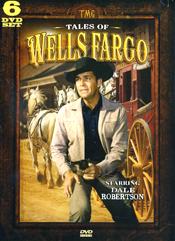Dale Robertson, who joined those ghost riders in the sky this week at the age of 89, was the first celebrity I ever met. And though I went on to interview hundreds more as a media and entertainment writer, it’s still one of my favorite encounters.
I was 12 years old when Robertson, riding high as the star of NBC’s popular Western series Tales of Wells Fargo, visited my little hometown, Laurel, Mississippi. He was pals with a local car dealer who shared his passion for raising and riding quarter horses.
Robertson made a guest appearance at Red Martin’s car lot on a sunny Saturday to help drum up some business. He had driven to Laurel from out West in the customized convertible that his show’s sponsor, Buick, had given him as a token of appreciation. It was parked on Martin’s lot when my dad pulled in his 1954 Ford pick-up with me and my buddy, Leslie Davies, in the cab. Daddy wasn’t exactly the star-struck type, but he respected cowboy actors like Robertson who knew how to sit a horse.
The customized Buick was the most fabulous vehicle we had ever seen. Even today, I would take it over the Batmobile or Knight Rider’s KITT. It was white, waxed to a blinding shine, with gorgeous brown leather interior stitched like a fine saddle, a holstered, chrome-plated six-gun on each interior door, and a longhorn steer-head for a hood ornament. People stood around it at a respectful distance, staring at it as though it were the spaceship in The Day the Earth Stood Still.
Robertson appeared this day not in his Jim Hardie/Wells Fargo costume but in a summer sport shirt and slacks. The only nod to cowboy-ism was his handsome pair of boots.
Red Martin introduced him, and he hopped up on a low stack of Royal Crown Cola crates to make some remarks to the crowd, most about his host’s ranch and the beautiful working horses he raised. When he was done, he offered to take questions.
My buddy Leslie, an incorrigible smart-ass who could have been the model for Bart Simpson, raised his hand. Robertson pointed to him.
“Why would you ride quarter horses?” Leslie asked. “Wouldn’t it be better to ride whole ones?”
Robertson looked as Leslie like he would have pulled his revolver if he’d been strapping. Then he sort of rolled his eyes and recognized another questioner.
Afterwards, when he was signing autographs, I apologized on behalf of my friend and told him I was such a big fan of Wells Fargo I was trying to learn to draw my gun left-handed in homage to agent Jim Hardie. He asked me and a few other kids if we would like to sit in the Buick. We took turns sitting behind the wheel, but only after one of Red Martin’s salesmen brought over a mat on which we had to wipe our feet. Even Leslie eventually got a turn.
 Robertson was never a great actor, but he had an outsized personality, gregarious and confident. He carried himself with a swagger, like he was a walking tall tale. Wells Fargo, which ran for five seasons, was the peak of his success. A second Western series, The Iron Horse, never caught on, nor did J.J. Starbuck, a series about a rich Texan who drove around the country in a convertible much like the legendary Buick — it had actual cow horns on the hood — solving crimes and helping people out of jams.
Robertson was never a great actor, but he had an outsized personality, gregarious and confident. He carried himself with a swagger, like he was a walking tall tale. Wells Fargo, which ran for five seasons, was the peak of his success. A second Western series, The Iron Horse, never caught on, nor did J.J. Starbuck, a series about a rich Texan who drove around the country in a convertible much like the legendary Buick — it had actual cow horns on the hood — solving crimes and helping people out of jams.
Starbuck and the recurring characters Robertson played on both Dallas and Dynasty were well tailored to Robertson’s robust persona, but for me, the role of his career was the title character in Melvin Purvis, G-Man, a 1974 made-for-TV movie in which he played the FBI agent who led the hunts for Baby Face Nelson, John Dillinger and other Depression-era most-wanteds. The real Purvis was notorious publicity hound, and Robertson, working under the direction of Dan Curtis (The Night Stalker) with a script by John Milius (Dirty Harry, Apocolypse Now), played him with full-throttle flamboyance, resplendent in double-breasted period suits and waving a big cigar as he plotted strategy and held court. If this wasn’t the real deal, it was very close to the real Dale.